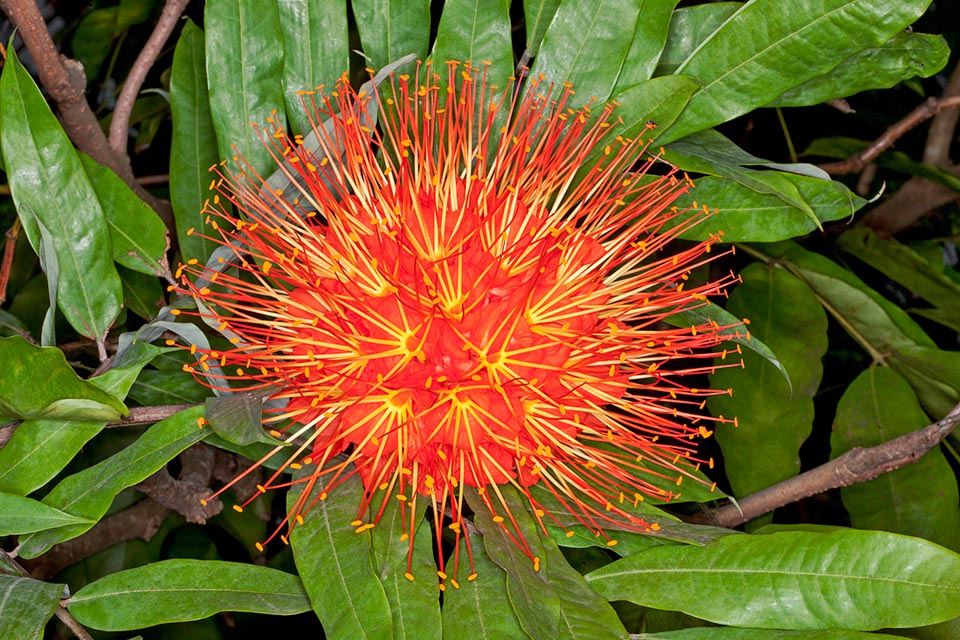Family : Fabaceae

Text © Pietro Puccio

English translation by Mario Beltramini
The species is native to tropical central-southern America (Colombia, Ecuador, Panama, Peru and Venezuela), where it grows in the humid thick forests at low altitudes.
The genus is honoured to the Irish botanist Patrick Browne (1720-1790); the name of the species is the combination of the Greek terms “makros” = big and “phyllon” = leaf, with obvious reference.
Common names: Panama flame, Panama flame tree, rose of Venezuela (English); cacique negro, cuchillito, palo de la cruz, rosa da Venezuela, rosa de mata, rosa de monte, rosa de montaña (Spanish).
The Brownea macrophylla Linden (1863) is an average sized tree, up to about 10 m tall and with diameter of the trunk of 20-25 cm, with long branches, villous initially, tending to lean on the other trees. The 20-40 cm long leaves are paripinnate and are composed by 5-7 pairs of elliptic-lanceolate leaflets, 10-25 cm long and 2,5-6 cm broad, with long pointed apex, of glossy intense green colour above, slightly pubescent below; the young leaves are of nearly white to pink colour, grouped and hanging as in the other species belonging to the genus. Inflorescence directly on the trunk and on the main branches, globose, of 15-25 cm of diameter, carrying 30-50 flowers strictly in contact each other, with the single flowers formed by 5 red obovate petals, about 3 cm long and 1-1,5 cm broad, 10-15 orange red stamina, 8 cm long, united at the base in 2,5 cm long tube and by the 10 cm long pistil; the flowers, rich of nectar, are pollinated mainly by the hummingbirds.

Even 10 m tall, Brownea macrophylla is a tree of tropical Central-South America. As the name states, the compound leaves have a good size: 20-40 cm long with 20-25 cm leaflets. The inflorescences, 15-25 cm broad with 30-50 flowers very close each other, get out from the trunk or the main branches. Rich of nectar, are mainly pollinated by hummingbirds. Species rare in nature but frequent in tropical gardens due to its showy blooming and the new white-pinkish drooping leaves © G. Mazza
It reproduces by seed which must be interred shortly after the collection, having a short lasting germinating ability; the seeds are to be directly interred or placed in pot, in substratum rich of organic substance with addition of sand or agri-perlite around the 30%, at a temperature of 24-28 °C, taking care of not damaging the rooting apparatus, particularly sensitive, in the transplants; the germination takes place usually in 1-2 months and the first flowering starting from the third, fourth year of age.
Species nowadays fairly rare in the wild, it stands among the most ornamental tropical trees for the showy flowering as well as for the appearance and the typical colour of the new leaves, cultivable exclusively in tropical and humid subtropical climate zones with lowest temperatures never under the 12-14 °C. It requires a particularly luminous position, even in full sun when adult, or partially shaded, and deep, draining, rich of organic substance, soils, from slightly acidic to neutral, kept permanently humid. Where the permanent positioning in open air is not possible, it can be cultivated in big pots or tubs placed in luminous greenhouses with winter lowest temperatures preferably not less than 15 °C; the waterings must be regular and abundant in summer, reduced in winter, but without ever allowing the substratum to dry up completely. The wood, with the duramen (the heartwood) of blackish colour, is utilized in the construction of furniture.
→ To appreciate the biodiversity within the family of FABACEAE please click here.
